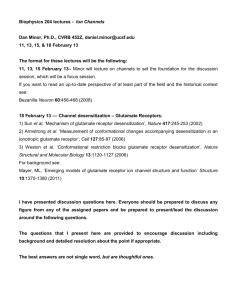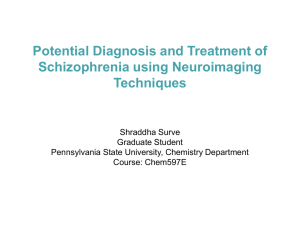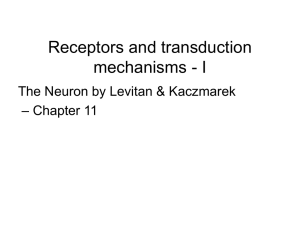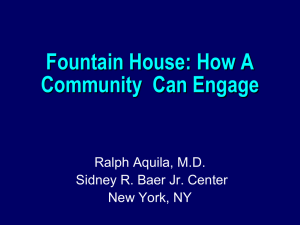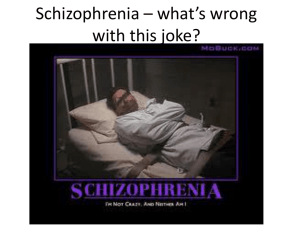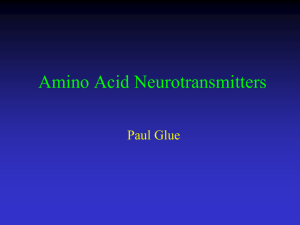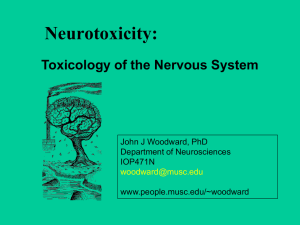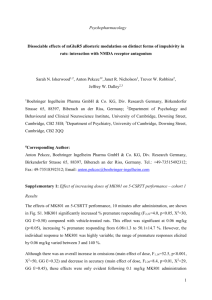mgluR`s in schizo.
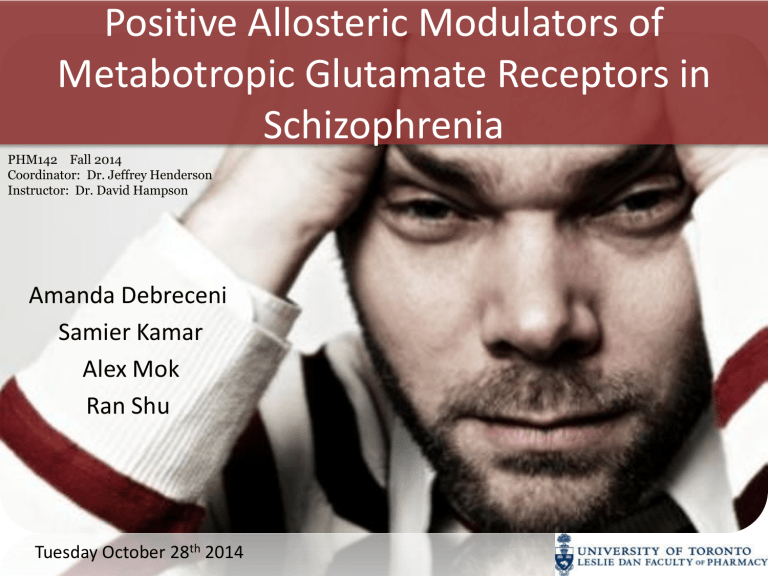
Positive Allosteric Modulators of
Metabotropic Glutamate Receptors in
Schizophrenia
PHM142 Fall 2014
Coordinator: Dr. Jeffrey Henderson
Instructor: Dr. David Hampson
Amanda Debreceni
Samier Kamar
Alex Mok
Ran Shu
Tuesday October 28 th 2014
Learning Objectives
• Define schizophrenia
• Define PAM (Positive Allosteric Modulators)
• Metabotropic Glutamate Receptors
(mGluR2/mGluR3)
• Pre-Clinical trials concerning PAMs
• Current and future treatments for schizophrenia
• Summary slide
What is Schizophrenia?
• Complex disease with:
– Positive Symptoms
Cognitive
Impairments
– Negative Symptoms
• Current Treatments have side effects:
– Less effective in reducing the negative symptoms
Positive Allosteric Activation
Types of Glutamate Receptors
Metabotropic Glutamate Receptor
Schizophrenic
Location of mGluR2 and mGluR3
• Mostly in the forebrain
– In presynaptic neurons throughout the prefrontal cortex
Location of mGluR2 and mGluR3
• Mostly in the forebrain
– Highest mRNA levels of mGluR2 are found in the prefrontal cortex
Compounds in the Literature Currently
• Agonists of group II mGluR (mGluR2 and mGluR3)
– LY404039 (Phase II and III)
• Positive Allosteric Modulators
– More specific (target mGluR2 only)
– LY487379 (LY48) and others of first series
– Biphenyl-indanone A (BINA) and second series
BINA Experiments in Mice
• Effectiveness in Different Mouse Models (2
Models)
– Amphetamine-Induced Hyperlocomotor Activity
– PCP-Induced Hyperlocomotor Activity
• Compared to LY487379
– Different Results
– BINA has longer half-life
Discussion of Experiment
• Off target effects?
• Agonist Receptor Trafficking
• Evidence that mGluR2 PAMS can be an alternative to Agonists
Treatments for Schizophrenia
• Drugs Targeting Dopamine Imbalance
• Psychosocial Therapy
• Electroconvulsive Therapy
• Drugs Targeting Glutamate?
Summary Slide
• Schizophrenia is a complex disease characterized by positive and negative symptoms (positive: hallucinations, negative: social withdrawal)
• It is characterized by cognitive impairments and increased glutamate in the prefrontal cortex limbic system
• Glutamate exacerbates the symptoms of schizophrenia patients
• PAM- Binds to an allosteric site (not active site), enhances the activity of the agonist leading to downstream effects
• Glutamate Receptors are Metabotropic Receptors
• In schizophrenic patients, there is reduced G
αi
+ calcium ion increase = increased glutamate activity, leading to increased adenylyl cyclase activity
• In normal patients, G
αi inhibits the effect of adenylyl cyclase activity and calcium activity
• BINA blocks the PCP-Induced Hyperlocomotor Activity whereas LY487379 blocked the
Amphetamine-Induced Hyperlocomotor Activity
• The differences may be due to off target effects, which means that different compounds can activate different pathways from the same receptor.
• Treatments for Schizophrenia
– Drugs Targeting Dopamine Imbalance
– Psychosocial Therapy
– Electroconvulsive Therapy
– Drugs Targeting Glutamate Imbalance in the future
References
• Eli Lilly and Company - Lilly Stops Phase III Development of Pomaglumetad Methionil For the Treatment of
Schizophrenia Based on Efficacy Results, Eli Lilly, 29 August 2012 https://investor.lilly.com/releasedetail.cfm?ReleaseID=703018
• Conn, J. et al., 2009. Activation of metabotropic glutamate receptors as a novel approach for the treatment of schizophrenia. Trends in Pharmacological Sciences. 3 (1): 25-31.
• Fell, M. J. et al., 2012. Group II metabotropic glutamate receptor agonists and positive allosteric modulators as novel treatments for schizophrenia. 52 (3): 1473-1483.
• Fraley, M. E. (2009). Positive allosteric modulators of the metabotropic glutamate receptor 2 for the treatment of schizophrenia. Expert Opinion on Therapeutic Patents, 19 (9): 1259–75.
• Frooninckx, L. et al., 2012. Neuropeptide GPCRs in C. elegans. Front Endocrinology, 3: 167.
• Galici R, Jones CK, Hemstapat K, Nong Y, Echemendia NG, Williams LC, et al. Biphenyl-indanone A, a positive allosteric modulator of the metabotropic glutamate receptor subtype 2, has antipsychotic- and anxiolytic-like effects in mice. The Journal of pharmacology and experimental therapeutics. 2006;318(1): 173-85.
• Ghose, S et al., 2009. Differential Expression of Metabotropic Glutamate Receptors 2 and 3 in Schizophrenia: A
Mechanism for Antipsychotic Drug Action? Am J Psychiatry. 166:812-820.
• Introduction to Enzymes - Boundless Open Textbook. Boundless. N.p. Web. 10 Oct. 2014. https://www.boundless.com/microbiology/textbooks/boundless-microbiology-textbook/chemistry-2/enzymes-
27/introduction-to-enzymes-236-11577/
• Konradi, C., & Heckers, S. (2003). Molecular aspects of glutamate dysregulation: implications for schizophrenia and its treatment. Pharmacology & Therapeutics, 97 (2): 153–179.
• Krivoy, A., T. Fischel and A. Weizman. 2008. The possible involvement of metabotropic glutamate receptors in schizophrenia. European Neuropsychopharmacology. 18 (6): 395-405.
• Patil ST, Zhang L, Martenyi F, Lowe SL, Jackson KA, Andreev BV, Avedisova AS, Bardenstein LM, Gurovich IY,
Morozova MA, Mosolov SN, Neznanov NG, Reznik AM, Smulevich AB, Tochilov VA, Johnson BG, Monn JA, Schoepp
DD (September 2007). "Activation of mGlu2/3 receptors as a new approach to treat schizophrenia: a randomized
Phase 2 clinical trial". Nature Medicine 13 (9): 1102–7

